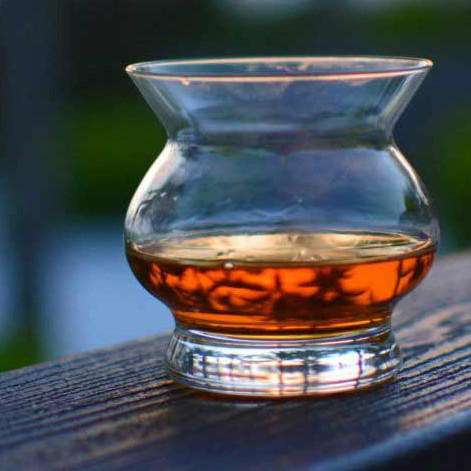Exploring the Dimensions of Rum: A Guide to the Five Types of Glasses for Tasting
Tasting rum is an art that goes far beyond mere sipping. Each sip unveils a symphony of aromas and flavors that intertwine to create a unique sensory experience. However, A Guide to the Five Types of Glasses for Tasting, a fundamental aspect to fully appreciate all the qualities of rum is the choice of the right glass. In this article, we will explore in detail five types of glasses used in rum tasting and how each one influences our perception of this distillation.
In an exciting episode of “Aqui se Habla de Ron” (Here We Talk About Rum), available on Zavvy Livestream, Fede Hernandez, Jaiker Soto, Ramon Almao, and Daniel Mora gathered to discuss various aspects of rum tasting, including the importance of the appropriate glasses. These professionals shared their knowledge and experiences, providing profound insights into how glasses can shape our appreciation of rum.
Neat Glass: Elevating the Purity of the Experience
One of the most iconic glasses in rum tasting is the Neat Glass. This glass is characterized by its simple and elegant design, with a wide base that tapers towards the top. During the discussion, the importance of this glass in appreciating the essence of rum without any interference was highlighted.
The Neat Glass is especially effective at highlighting the purity of the aromas and flavors of rum. As Fede Hernandez mentioned, this minimalist design allows aromatic nuances to unfold unobstructed, offering an authentic tasting experience. The conical shape of the glass concentrates aromas at the rim, allowing the taster to explore each nuance with clarity and precision.
This glass is ideal for rums that are meant to be appreciated in their purest form, such as those with complex and balanced aromatic profiles. By avoiding excessive dispersion of aromas, the Neat Glass allows flavors to present themselves directly and honestly on the palate, providing a distraction-free experience.
Glencairn Glass: Revealing the Depth of Aromas
Another prominent glass in rum tasting is the Glencairn Glass. This glass features an elegant shape with a wider base that tapers towards the top, creating a sort of dome. During the conversation, Jaiker Soto emphasized the importance of this glass in revealing the depth and complexity of rum aromas.
The design of the Glencairn Glass allows for aromas to be concentrated in the dome area, enhancing the olfactory characteristics of the rum. Ramon Almao pointed out that this directed shape of the aromas towards the taster’s nose enables a more intimate appreciation of the nuances present in the beverage. Aromas are concentrated and released gradually as they mix with the air, providing a layered aromatic experience.
The Glencairn Glass is particularly suitable for rums with a wide variety of aromas, such as those with fruity, spicy, and smoky notes. The conical shape and concentration of aromas allow these aromas to unfold gradually, offering the taster the opportunity to explore each aromatic layer in detail. This glass becomes an essential tool for those seeking to appreciate the aromatic complexity of rum.
Tulip Glass: Elevating the Rum Tasting Experience
Within the exciting universe of rum tasting, the Tulip Glass emerges as a fundamental instrument for exploring the intricacies and nuances of this exquisite spirit. During the fascinating conversation among the renowned rum experts, significant details about the Tulip Glass and its crucial role in the appreciation and analysis of different rum profiles were unveiled.
The Tulip Glass, recognizable by its curved and stylized shape, is conceived as a masterpiece of design intended to optimize the sensory experience of rum tasting. The experts agree that this glass is particularly suitable for rums that exhibit a wide range of aromas and flavors, as its shape allows for the capture and concentration of subtleties in the beverage.
A key aspect of the Tulip Glass is its ability to preserve and enhance the aromas of rum. As Ramon Almao noted, the curved shape of the glass prevents lighter alcoholic vapors from evaporating rapidly, ensuring that aromatic nuances remain present during sensory evaluation. This allows tasters to explore and enjoy olfactory notes with greater precision and enrichment.
Fede Hernandez shared his perspective on how the Tulip Glass influences flavor appreciation. Thanks to its design, this glass guides the beverage to the front of the tongue, where sweet flavors are perceived, and then extends to the sides and back of the mouth, where more complex and astringent notes are captured. This gradual tasting process contributes to a comprehensive understanding of the qualities of rum.
The choice of the Tulip Glass for rum tasting is a decision that reflects the pursuit of excellence and dedication to detailed appreciation. As affirmed by the rum experts during their conversation, this glass allows for meticulous exploration and a complete sensory experience. For rum enthusiasts seeking to delve into the depths of each distillate, the Tulip Glass stands as an indispensable companion on the journey to discovering the unique flavors and aromas that rum has to offer.
Globe Glass: Expanding the Sensory Spectrum
Among the various types of glasses used in rum tasting, the Globe Glass stands out as an instrument designed to expand the sensory spectrum and provide an immersive experience. During the discussion among the experts, the importance of this glass in the appreciation of rums with rich and diverse flavor profiles was highlighted.
The Globe Glass is distinguished by its rounded shape and ample cavity, which allow for greater exposure of the rum to air. As mentioned by Jaiker Soto, this increased exposure enables aromas to develop and blend more efficiently, providing an intense and enveloping sensory experience. The rounded shape of the glass also allows aromas to concentrate at the center, offering a potent presentation to the olfactory senses.
This glass is particularly suitable for rums with complex and robust flavor profiles, such as those aged in oak barrels or with smoky nuances. The wide cavity of the Globe Glass allows aromas to blend and present themselves harmoniously, providing the taster with a complete appreciation of the layers of flavors present in the rum.
Old Fashioned Glass: A Deep Journey Through Aromas
One of the most iconic types of glasses in rum tasting is the Old Fashioned Glass, also known as a short glass. This glass is characterized by its robust design and wide base, making it a popular choice among connoisseurs and rum lovers. During the discussion, the importance of this glass in fully appreciating the nuances of rum was emphasized.
The Old Fashioned Glass is particularly effective at highlighting the evolution and complexity of rum aromas. As mentioned by Daniel Mora, this design allows for aromas to evaporate, enhancing the notes present in the spirit. Its wide base and compact shape help concentrate aromas in a smaller space, providing an intense and profound sensory experience.
When rum is poured into the Old Fashioned Glass, aromas are released gradually as they mix with the air. This allows aromatic nuances to become more evident and distinguishable, providing a detailed insight into the qualities of the rum. Additionally, the shape of the glass guides aromas to the nose more directly, enabling a more precise appreciation of the subtle and complex notes present in the beverage.
This glass is particularly suitable for rums that exhibit notes of caramel, vanilla, dried fruits, and wood. The concentration of aromas in the Old Fashioned Glass allows these characteristics to be highlighted, providing the taster with a complete and rich experience. Furthermore, the smaller size of the glass promotes greater contact between the rum and air, facilitating the release of aromatic compounds and their subsequent appreciation.
Conclusion
Each of these five glasses offers a unique perspective in rum tasting. Whether seeking the purity of the Neat Glass, the depth of the Glencairn Glass, the complete experience of the Tulip Glass, the expansiveness of the Globe Glass, or the aromatic journey of the Old Fashioned Glass, each glass choice adds an additional dimension to the appreciation of this distillation. The richness of aromas and flavors that rum has to offer unfolds differently in each type of glass, and the choice of one or the other depends on the occasion and the desire to explore every facet of this exquisite spirit.
About The Author
Camilo is an audiovisual communicator with over 15 years of experience. He resides in Caracas, Venezuela, and has studied film and television, acquiring skills in writing film scripts. He currently works as a Digital Content Manager at TRL. If you would like to see his portfolio, you can visit his website at http://ccesarino.com.










